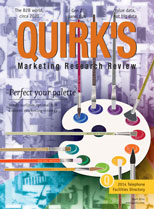Editor's note: Lynnette S. Van Dyke is principal and founding partner at KS&R, a Syracuse, N.Y., research company. She can be reached at lvandyke@ksrinc.com. This article appeared in the April 7, 2014, edition of Quirk's e-newsletter.
One of the cornerstones of success in qualitative research is to create an accepting environment in which respondents feel comfortable enough to share their innermost thoughts and feelings. This can be particularly challenging with B2B respondents, who often find it difficult to go beyond their professional boundaries.
Team-building activities can shake up respondents' perceptions and beliefs; energize low energy groups; and help uncover breakthrough ideas and opportunities. There are generally four types of team-building activities: communication; problem-solving/decision-making; planning/adaptability; and trust-building. With literally thousands of these activities available, it is important to choose the right one for your session.
- Make certain that activity can be conducted in the time and space available.
- Analyze the activity for potential trouble spots (e.g., respondent misunderstanding, complaints, showing off, etc.) and decide ahead of time how you will deal with each issue.
- Build flexibility into the process. Respondents learn at different rates and play differently. Emotional needs and willingness to take risks can vary dramatically.
One of my go-to problem-solving team-building activities for B2B respondents is based off the wordless picture book Zoom, by Istvan Banyai. Zoom features 30 sequential pictures-within-pictures. Its narrative moves from a rooster to ship to a city street to a desert island and finally, outer space. Because Zoom has been published in 18 countries, this activity is especially well-suited to global qualitative research studies. It is also very effective in illustrating to businesspeople how their perspectives can impact and change realities.
Here's how to use Zoom:
- Separate the pages of the book into one-page sheets. Laminate each page or place it in a clear plastic sleeve.
- Hand out one picture to each respondent (be sure to use a contiguous sequence).
- Allow respondents a few minutes to study their pictures. Make sure that they keep their pictures hidden from others.
- The goal is for the group to sequence the pictures in the correct order through discussion (usually five-to-seven minutes).
- When the group believes they have all the pictures in the correct order, the pictures are turned around for everyone to see.
Unexpected, offbeat and playful exercises help respondents to get acquainted and relax and create an atmosphere of shared interests and values. Team-building activities can go a long way in creating that environment.
